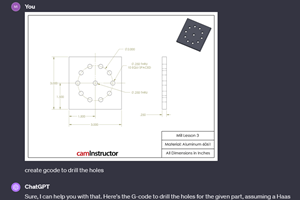A Realistic Definition Of Cycle Time
Many people determine cycle time by measuring cycle start to cycle start time. As the operator presses the cycle start button, he or she starts the stopwatch.
Share





Many people determine cycle time by measuring cycle start to cycle start time. As the operator presses the cycle start button, he or she starts the stopwatch. The cycle runs and eventually the machine stops. The operator removes the workpiece and loads the next one. As the next cycle is activated, the stopwatch is stopped. The elapsed time on the stopwatch, which includes load/unload, is the cycle time.
While the cycle start to cycle start time is very important, it does not take into consideration those things that do not happen in every cycle. Say, for instance, that you have a 1,000-part production run and the cycle start to cycle start time is precisely three minutes. Will your production run be completed in 3,000 minutes? Unless you've already perfected cycle time reduction for your company, it probably won't. It's likely the actual production run will take much longer.
What causes the difference? There are probably many things the operator is doing that do not occur in every cycle, but these add to the length of time it takes to complete the production run. Tool maintenance, warm-ups, machine cleaning, offset adjustments and even personal time are but a few examples.
Here is a more realistic—though admittedly more difficult to predict—definition of cycle time. Cycle time is the amount of time it takes to complete a production run divided by the number of acceptable workpieces produced. For lack of a better term, we refer to this measure as the throughput time. If our 1,000-piece production run takes 5,000 minutes to complete, throughput time is five minutes.
Too many companies place great emphasis on reducing cycle start to cycle start time, but they pay little or no attention to throughput time. It's not uncommon, for instance, to reduce cycle start to cycle start time by getting more aggressive with speeds and feeds, greater depths of cut, and so on. But the additional tool maintenance time caused by these more aggressive cutting conditions is often overlooked. In reality, attempting to reduce cycle time in this manner may not provide the expected benefit. In fact, increasing cutting conditions to reduce cycle start to cycle start time may even increase the time it takes to complete the production run if tool maintenance must be done while the machine is down.
We urge you to compare cycle start to cycle start time with throughput time for a few of your longer running jobs. You may be very surprised at the difference. It's not a bad idea to document both times right in your CNC program. It is not uncommon to find that throughput time is at least 20 percent longer than cycle start to cycle start time. We've seen it over 50 percent longer!
When it comes to cycle time reduction, target reducing the difference between throughput time and cycle start to cycle start time is a primary goal. Minimize the impact of tool maintenance by moving it off-line (when the machine is not running) or by making maintenance as quick and easy as possible for the operator to perform. Be sure operators have all inserts and other cutting tool components at their fingertips. Be sure operators know they can be making offset adjustments for the purpose of holding size while the machine is running. Machine cleaning and warm-ups can be done while the machine is normally out of production, such as during lunch, breaks or off-shifts. As you study your own cycles and compare them to throughput time, you'll surely come up with ways to save time.
Related Content
The Power of Practical Demonstrations and Projects
Practical work has served Bridgerland Technical College both in preparing its current students for manufacturing jobs and in appealing to new generations of potential machinists.
Read MoreCan ChatGPT Create Usable G-Code Programs?
Since its debut in late 2022, ChatGPT has been used in many situations, from writing stories to writing code, including G-code. But is it useful to shops? We asked a CAM expert for his thoughts.
Read MoreCan AI Replace Programmers? Writers Face a Similar Question
The answer is the same in both cases. Artificial intelligence performs sophisticated tasks, but falls short of delivering on the fullness of what the work entails.
Read More2 Secondary Coordinate Systems You Should Know
Coordinate systems tell a CNC machine where to position the cutting tool during the program’s execution for any purpose that requires the cutting tool to move.
Read MoreRead Next
Machine Shop MBA
Making Chips and 91ÊÓƵÍøÕ¾ÎÛ are teaming up for a new podcast series called Machine Shop MBA—designed to help manufacturers measure their success against the industry’s best. Through the lens of the Top Shops benchmarking program, the series explores the KPIs that set high-performing shops apart, from machine utilization and first-pass yield to employee engagement and revenue per employee.
Read MoreAMRs Are Moving Into Manufacturing: 4 Considerations for Implementation
AMRs can provide a flexible, easy-to-use automation platform so long as manufacturers choose a suitable task and prepare their facilities.
Read More.jpg;width=70;height=70;mode=crop)


















